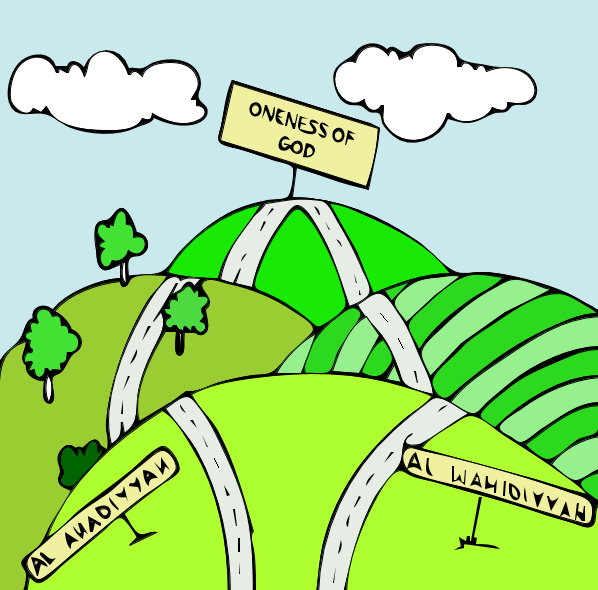The Second Station of the Fourteenth Flash (Part 3)
NOTE: The quoted passages are from Ustadh Bediuzzaman’s book and the commentaries below them are my own.
Second Mystery: In order to avoid drowning the minds in Divine Unity (Al-Wahidiyyah), [which] appears in the boundless abundance of creatures; the Quran of miraculous exposition continuously shows the manifestation of Divine Oneness (Al-Ahadiyyah) within Divine Unity (Al-Wahidiyyah). That is to say, for instance, the sun encompasses boundless things with its light. Since to think about the entity[1] (dhat) of the sun in the totality of its light requires an immensely vast imagination and an encompassing view; so lest the entity of the sun be forgotten, it shows the entity of the sun in every shining object through reflection. And every shining object, depending on its potential, shows the manifestation of the sun’s entity along with such properties as its light and heat. And just as every shining object, with regard to its potential, shows the sun with the entirety of its attributes; so also each of such properties as the light and heat of the sun and the seven colors [contained] within light, encompasses all the objects facing it. Similarly, [2] وَلِلَّهِ الْمَثَلُ الْأَعْلَىٰ – let there be no mistake in the example – just as Divine Oneness (Al-Ahadiyyah) and Sufficiency (As-Samadiyyah) have a manifestation in every object particularly in [every] living being, [and more] specifically in the mirror of the human essence with all names [of Allah ﷻ],; so too by the aspect of Singleness (Al-Wahdah) and Divine Unity (Al-Wahidiyyah), every name related to the beings encompass all of the beings [as a whole].
Thus, in order to avoid drowning the minds in Divine Unity (Al-Wahidyyah) and in order that the hearts do not forget The Most Holy One[3] (Dhat Al-Aqdas), [the Qur’an] continuously points to the stamp of Divine Oneness (Al-Ahadiyyah) within Divine Unity (Al-Wahidiyyah), and it is بِسْمِ اللهِ الرَّحْمٰنِ الرَّحِيمِ “In the name of Allah, the Merciful, the Compassionate” which demonstrates the three essential points of that stamp.
The Turkish word for “divine unity” is “vahidiyet”, while the Arabic word is “الواحدية” (Al-Wahidiyyah). Notice that the Turkish term substitutes “w” for “v”, since the sound “w” does not exist in Turkish. The Turkish and Arabic words for “divine oneness”, on the other hand, are “ehadiyet” and “الأحدية” (Al-Ahadiyyah), respectively. The letter “e” in Turkish is pronounced as the “a” in English. “الواحد” (Al-Wahid) and “الأحد” (Al-Ahad) are two names of Allah (SWT) meaning “The Unique/Indivisible One” in two different ways. In this post, we will analyze the difference between them.
The words Al-Wahid/Al-Ahad (One) and Al-Wahidiyyah/Al-Ahadiyya (Oneness) are two different forms of the same word. The Twentieth Letter gives us the following definitions, Al-Wahidyyah/Vahidiyet (divine unity): “Divine Unity (Al-Wahidiyyah) means all beings [belong] to One and look to One and are the invention of One.” Al-Ahadiyyah/Ehadiyet (divine oneness): ” Divine Oneness (Al-Ahadiyyah) means [that] most of the names of The Creator of everything is manifested in everything.” Recall the difference between the names Ar-Rahman (The All-Merciful) and Ar-Raheem (The All-Compassionate) in the previous post. They both indicate the mercy of God in different ways. Ar-Rahman (The All-Merciful) points to the mercy seen in the universe as a whole, while Ar-Raheem (The All-Compassionate) points to the mercy seen in particular beings. Similarly, Al-Wahidiyyah (divine unity) and Al-Ahadiyyah (divine oneness) both indicate the oneness of God in different ways. Al-Wahidiyyah (divine unity) shows the oneness of God when observing something as a whole (as composed of parts), while Al-Ahadiyyah (divine oneness) shows His oneness in every particular being. In other words, Al-Wahidiyyah and Al-Ahadiyyah are two paths taking us to the Oneness of God.
Al-Wahidiyyah (Divine Unity)
Let us take a look at a simple example for Al-Wahidiyyah (Divine Unity). Across the centuries, there have been many religions claiming the existence of more than one God. The interconnectedness of the universe, however, defies this belief. How so? Suppose that, for instance, a certain belief claims to have three separate creators for water, air, and soil. Since the Water God created water, and since water consists of oxygen and hydrogen; the Water God must also be the Creator of these elements. However, this would mean that the Water God is also the Creator of electrons, neutrons, quantum physics, mathematics, and so on. In other words, the Water God must be the Creator of this universe. Just as the knowledge of a scholar is a manifestation of the name Al-Alim (The All-Knowing), and just as wealth is a manifestation of the name Al-Ghani (The All-Sufficient); the interconnectedness among the beings of this universe is a manifestation of the name Al-Wahid (The One). That is, by looking at the universe as a whole (as composed of different parts), we see the interconnectedness around us, which in turn allows us to understand and to observe the oneness of God.
Al-Ahadiyya (Divine Oneness)
God has many different names and most of His names are manifested in every single being. What are the names manifested in, for instance, a flower? Try to think of how many textbooks have been devoted for simply describing the biology of these flowers. This implies that the Creator of this flower must be Al-Alim (The All-Knowing). He must also be Al-Qadir (The All-Powerful), for how else would He create these flowers? He must be Ar-Razzaq (The Provider), since the flower cannot grow without nourishment, and so on. In other words, by looking at anything in the universe, we can see most of the names of God being manifested or displayed. Furthermore, the beauty and greatness of a flower is not any less than that of the universe as a whole. In other words, by looking at a single flower and the magnificence in its creation; we understand that the One capable of creating this flower must also be capable of creating this universe. Now suppose that there were two different Gods, say the God of flowers and the God of sea stars. Since everything in this universe manifests most of the names of God, the Creator of a flower must share the same names with the Creator of sea stars. In particular, both creators must be ultimately powerful. Thus, any simple disagreement between these creators would result in uncontrollable chaos and turmoil in this universe. Hence, the order and harmony seen in this world despite its complexity defies polytheism as well. Imagine what would happen if there were two rulers in the same country, two principals in one school, two captains in one army, and so on. The following is a verse from the Noble Qur’an,
لَوْ كَانَ فِيهِمَا آلِهَةٌ إِلَّا اللَّهُ لَفَسَدَتَا ۚ فَسُبْحَانَ اللَّهِ رَبِّ الْعَرْشِ عَمَّا يَصِفُونَ
If there were, in the heavens and the earth, other gods besides Allah, there would have been confusion in both! but glory to Allah, the Lord of the Throne: (High is He) above what they attribute to Him! (Al-Anbiyaa, 22)[4]
To conclude, the names Al-Wahid and Al-Ahad both mean “The One, Unique God”. The difference is that we see the name Al-Wahid when observing something as a whole, as composed of various parts with possible interconnectedness/interdependence between these parts (eg. looking at the universe as composed of water, air, humans, animals). We see the name Al-Ahad by looking at a particular being (eg. Looking at a specific being/thing within the universe, such as a flower, pony, sea star). Observing water through Al-Wahidiyyah (Divine Unity) means to consider it as an object composed of oxygen and hydrogen (or going even further by considering the electrons, neutrons, etc). Viewing it through Al-Ahadiyyah (Divine Oneness), on the other hand, means to consider water as just water, a single object, and then to consider the names being manifested by it.
Furthermore, since most names of God are manifested in every particular being (with regards to Al-Ahadiyyah), we need not look at the whole of something to contemplate the oneness of God but only a particular of it. So, for instance, the oneness of God is apparent in the whole of the universe. We may, however, look at a single flower within that universe and arrive at the same conclusion. Similarly, instead of viewing a whole tree to contemplate His oneness, we may as well consider just a single leaf of it, and so on. In other words, Al-Wahidiyyah allows us to see God’s oneness in the whole of something, while Al-Ahadiyyah allows us to see it in every particular of that something. Notice the similarity with the difference between A-Rahman (The Merciful) and Ar-Raheem (The Compassionate).
The author gives the following analogy to illustrate the difference between Al-Wahidiyyah and Al-Ahadiyyah: “the sun encompasses boundless things with its light. Since to think about the entity[5] (dhat) of the sun in the totality of its light requires an immensely vast imagination and an encompassing view; so lest the entity of the sun be forgotten, it shows the entity of the sun in every shining object through reflection.” The fact that the “the sun encompasses boundless things with its light” corresponds to Al-Wahidiyyah, and the fact that “it shows the entity of the sun in every shining object through reflection” corresponds to Al-Ahadiyyah.
[1] The “entity of the sun” is the sun itself (i.e. it is not the rays of the sun or the heat of the sun, but the sun in its totality). So, for instance, we do not see the entity of the sun by looking around us during the day and observing the sun’s light and feeling its heat; but we do see it by looking up directly at the sun. –TN
[2] And to Allah belong the most exalted attributes
[3] Al-Quddus is one of the names of Allah ﷻ having such meanings as Pure and Holy (Note: Aqdas is a form of the word Quddus; Quddus means “Pure and Holy”, while Al-Aqdas means “The Most Pure and Holy”). – TN
[4] http://www.oneummah.net/quran/book/21.html
[5] The “entity of the sun” is the sun itself (i.e. it is not the rays of the sun or the heat of the sun, but the sun in its totality). So, for instance, we do not see the entity of the sun by looking around us during the day and observing the sun’s light and feeling its heat; but we do see it by looking up directly at the sun. –TN



